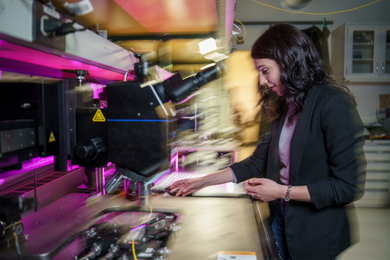An assistant professor and a senior in the Department of Chemistry have developed a way to cleave nitrogen molecules at room temperature and pressure, something that until now has only been accomplished by nitrogen-fixing bacteria.
Dr. Christopher Cummins and UROP student Catalina Laplaza, whose paper on the work appeared in the May 12 issue of Science, used a molecular complex centered around the transition metal molybdenum to break the extremely strong triple bond between the two atoms in N2, which comprises 78 percent of the earth's atmosphere. Nitrogen-containing products such as ammonia are widely manufactured and used, but a procedure called the Haber process is necessary to split N2 molecules and allow them to combine with other atoms. This process must be carried out in the presence of an iron catalyst at high temperatures and pressures, which requires a good deal of energy and is therefore expensive.
Dr. Cummins and Ms. Laplaza created a three-coordinate molybdenum complex (meaning a molecule with three subgroups attached to the central metal atom) and investigated its reaction chemistry. They found that two of these molecules could gravitate to each end of an N2 molecule and pull it apart. This reaction results in two molecules with a molybdenum-nitrogen triple bond, indicating that that bond is more than half as strong as the nitrogen-nitrogen bond, Dr. Cummins said.
Other scientists first showed about 30 years ago that nitrogen, normally an inert gas because of its high bond strength, could bond with transition metals. However, the method employed by nitrogen-fixing bacteria to cleave the molecules is not well understood, although scientists know that they utilize an enzyme called nitrogenase that contains molybdenum and iron. "Chemists are really fascinated by this because nitrogen is so inert-how do these bacteria do it?" Dr. Cummins said.
The work, which was funded by the Department of Chemistry and UROP, will not immediately result in new industrial methods; "the Haber process won't be usurped anytime soon," Dr. Cummins said. However, it offers information about nitrogen cleavage that may prove useful to scientists seeking a catalyst for future processes for using the nitrogen abundant in the atmosphere in making organic compounds.
"We're trying to understand how N2 reacts because we just don't have much information about that," he said. "This is really just a piece of the puzzle-there's a lot more to do."
A version of this article appeared in MIT Tech Talk on May 17, 1995.





